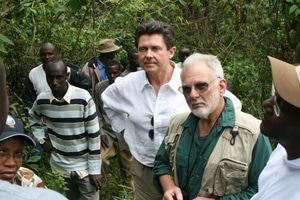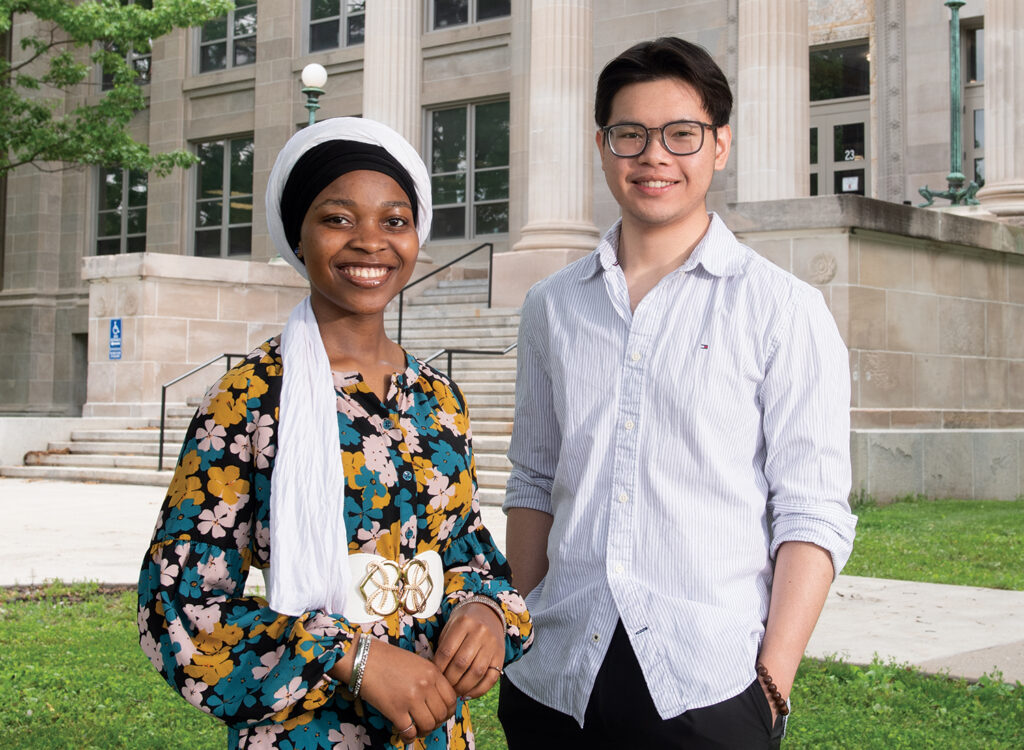Success in Africa
Des Moines businessman Ted Townsend realizes dream of saving Rwanda forest, chimps

PERRY BEEMAN Apr 9, 2015 | 11:00 am
7 min read time
1,637 wordsBusiness Record Insider, Economic DevelopmentWRITER’S NOTE: I visited Rwanda in 2009 as a fellow with the International Reporting Project. My series on Rwanda’s environmental initiatives, its work with Des Moines businessman Ted Townsend and the Great Ape Trust, and its economic programs, appeared in The Des Moines Register and is available at the IRP website. My blog is there, too. This story examines the recent success of Townsend’s team in persuading Rwanda’s cabinet to support an ambitious reforestation project in northwestern Rwanda. That nation’s parliament still has to approve the project, but that is considered a formality. I can still see the faces of the kind and hardworking villagers who at the time had no electricity, no water service and spent the day growing their own food. They were still recovering from the horror of the 1994 genocide that claimed nearly a million lives. They cleared much of the tiny Gishwati Forest for settlements, and for farmland. Now, the area will be reforested. Here, I share a motivational story of Iowans making a difference, thousands of miles away.
The years-long effort of Des Moines businessman Ted Townsend and colleagues to save two tiny forests and a group of chimpanzees in the small East Africa country of Rwanda is on the verge of success.
Rwanda’s Cabinet has approved the idea of declaring Gishwati and Mukura forests a national park, meaning they would be protected. Approval by Parliament is expected later.
It’s a big deal even for Rwanda, where President Paul Kagame’s reign following his overthrow of the Hutu regime to end the 1994 genocide has been surprisingly environmental-minded. Kagame has tried to sell foreign investors on the idea that Rwanda is less corrupt than neighboring countries and more interested in sustainability, two things many international aid programs want to establish before signing checks.
Part-time Urbandale resident Townsend and his colleagues from the Des Moines area helped establish a new Rwanda, from a different continent. More than once, they left the insurance buildings of Greater Des Moines for the “Land of a Thousand Hills,” where a forest had nearly disappeared, along with a small group of chimpanzees.
Because of this work, the isolated chimps that called Gishwati Forest home before Townsend showed up have an even better chance of survival. Even as Rwanda’s government mulled Townsend’s vision to restore the forest, the number of Gishwati chimpanzees grew to 24, double the level when work began under the moniker “Forest of Hope.” Part of that success came as “ecoguards” hired by Townsend’s team cracked down on forest-raiding, and as husband-wife researchers Rebecca Chancellor and Aaron Rundus, now of West Chester University in Pennsylvania, observed the chimps and learned more about their dietary habits.
“We are creating a ‘forest of hope’ that transcends the restoration of biodiversity,” Kagame wrote in a project publication. “It is about the people of Gishwati and improving their lives in harmony and nature. We are determined to reverse the history of human-induced environmental abuse in the Gishwati area, and this program is an opportunity for members of the global community to build partnerships with Rwanda and address these important challenges.”
Restoring forests lost to agriculture, settlement
The proposed national park designation for the Gishwati Forest area is part of a plan that would restore woodlands and establish a biological corridor between two forests that would help save the chimps.
In another show of support, the World Bank, blamed by many for supporting cattle ranching that fueled deforestation in the area, is providing $9.3 million for the protection effort.
Things are looking up for Gishwati, in part because some of the team Ted Townsend assembled is still working. Madeleine Nyiratuza, who coordinated the project for Townsend, now runs a nonprofit that supports the work. She was featured on CNN in October. See the video here.
In an interview via email, Nyiratuza said Townsend’s initiative was largely responsible for the national park designation.
“I believe that the work of Great Ape Trust is the foundation for Gishwati’s new status,” Nyiratuza wrote.
Townsend financed the work in Rwanda with pride. His father, the late businessman Ray Townsend, founder of Townsend Engineering Co., had implored him to take action when he saw a problem, especially a social one.
Eventually, Ted Townsend stopped paying for the Rwanda work so the government could take over as planned, but he still follows the work closely.
“The whole thing is about 99 percent the result of the collaboration of interested parties in Central Iowa,” Townsend said in an interview. “Without this effort, Gishwati would be gone — the trees, the chimps, everything.”
“It’s a success story for conservation, forestry and biodiversity in a part of the world that is fascinating and controversial at the same time,” Townsend added.
In an interview via email, Rose Mukankomeje, director general of the Rwanda Environment Management Authority, said it is unclear when that country’s Parliament will act, especially given economic troubles facing the nation. But Rose, as she is known throughout Rwanda, said the government strongly supports Townsend’s vision in the area, in part because saving the forest and the chimps will help boost tourism, one of the nation’s strongest industries.
Al Setka, a former Great Ape Trust spokesman who visited Rwanda to work on the project, said the project succeeded largely because of a meaningful partnership among the Rwanda-born staff at Gishwati and American colleagues, most from Des Moines, “The chimpanzee conservation and reforestation effort in Rwanda is a wonderful example of how a small number of dedicated people with an unwavering commitment to an honorable cause can make a significant impact in our world,” Setka said.
How did this all happen?
Townsend had gone to see the famous mountain gorillas of Rwanda, featured in the movie “Gorillas in the Mist,” about 18 months after the 1994 genocide ended. He had made several trips to the region to see gorillas and chimps, and always tried to talk to many residents. One woman had lost 97 of her 100 family members in the genocide, during which the Hutus killed Tutsis and moderate Hutus.
The 1994 killings marked the latest in a series of genocides in Rwanda and surrounding countries over the decades, 100 days of horror that left roads lined with children, women and men killed mostly with machetes.
To this day, Rwanda holds annual events to recall the atrocities, to respect the fallen and to plead, “Never again.” Clothes worn by the victims the day they died are stacked neatly in the pews of churches where they went to hide and were murdered, sometimes after clergy told the Hutus they were there.
Some women who weren’t killed were raped by men known to be HIV positive.
“I came away with a very sober reflection on how far humanity can fall,” said Townsend.
Eventually, Townsend had a chance to do his part to help Rwanda.
James Kimonyo, Rwanda’s ambassador to the United States, who was in Iowa for a speaking engagement, had said while visiting Townsend at his home in Urbandale in August 2007 that he would like to introduce the American businessman to President Kagame, often referred to as H.E. in Rwanda, for “His Excellency.”
As fate would have it, Kagame, a frequent visitor to the United States, was scheduled to attend the Clinton Global Initiative the next month. Townsend already planned to attend the Clinton event, where big thinkers meet people with big money, and was staying in the same hotel as Kagame.
Townsend wasn’t ready when Ambassador Kimonyo asked, on the elevator ride to Kagame’s room, what Townsend would propose to the Rwanda president that day. Townsend had planned to propose a handshake, and not much else. He thought it was just a meet-and-greet.
On the fly, Townsend hatched a plan to start a conservation project in a threatened area of forest. He made the pitch to Kagame, who loved the idea. The two, the leader of a country and a Greater Des Moines businessman, through their respective staffs later chose Gishwati for the work.
Townsend had boldly suggested that a country, which at that point was sporting huge rural areas with no electricity, running water or jobs, spend at least some of its time and resources persuading local residents not to turn two tiny forest fragments into charcoal and crafts, in turn robbing chimps of their home.
It was a tough sell.
Gishwati area families tend to spend their days growing the food they will eat, and until recently had not pursued much income outside the home.
Townsend opened a research station at Kinihira, on the edge of Gishwati, and an office in the city of Gisenyi. He hired local residents to help with research and to guard the forest. He brought in researchers from California, and, of course, from Great Ape Trust.
Key players
Des Moines staffers including Conservation Director Benjamin Beck and Peter Clay, who once worked for famed primatologist Dian Fossey, brought scientific and organizational expertise and assembled the team. They have moved on to other work now.
Townsend credits Beck, Clay and Al Setka, who handled the group’s communications, with much of the success in persuading local residents to cooperate in the work.
There were other Iowa connections. Drake University, William Penn University, Iowa State University and Simpson College all have had roles in the project at one time or another. Iowa college students helped with scientific research in Rwanda.
Now, the project has attracted the attention of the World Bank.
“The long-term vision is that protecting the Gishwati-Mukura area’s soil, water, forest and scenic riches will support a diverse and profitable economy, and ultimately boost tourism along the Lake Kivu shore,” said Stephen Ling, World Bank team leader. “Project activities and coordinated planning across government agencies will play a major role in meeting this goal.”
It’s a vision that began in Des Moines.










